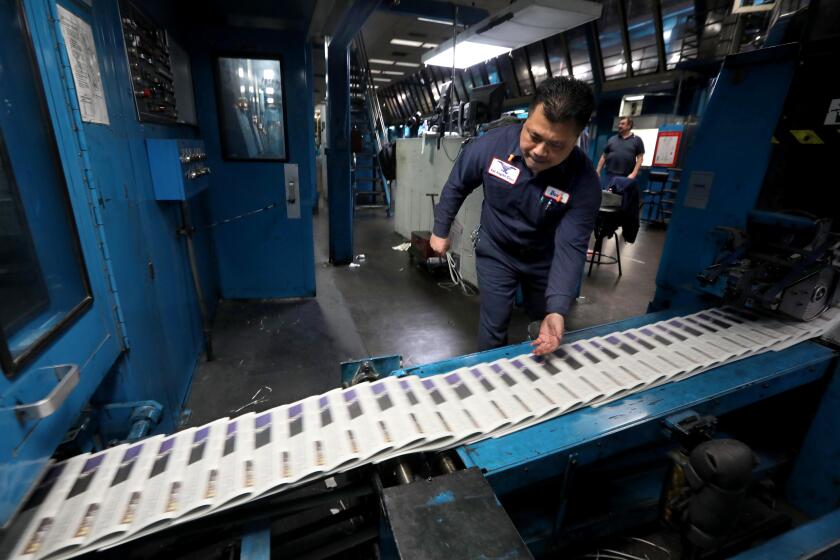Latino Middle Class Emerges as a Force
I walked into a big Highland Park storefront Tuesday night and saw the changing face of Los Angeles.
It was about an hour after the polls closed, and a room full of Latinos, along with a few Asian Americans and whites, were celebrating with City Councilman Mike Hernandez, who was cruising handily toward victory, despite a surprisingly strong challenge by Rose Marie Lopez.
At Dodger Stadium, a couple of miles south, our team was losing to the Mets, but few at this party cared.
They were cheering at a whole new ballgame.
Music was in the air, pans and plates of tamales, beans, meat and salad were on the table, along with bottles of Corona and Pacifico beer. The crowd spilled onto the sidewalk and parking lot, happy men and women, and even some kids, enjoying the moment. It looked like a family party, an enclave of energy in a city election that has been marked by apathy.
They had something more than a Hernandez victory to celebrate. An apparently record-setting Latino vote was helping deliver an unexpected victory for the $2.4-billion bond issue to rehabilitate the public schools so valued by a community whose children make up nearly 70% of those in the Los Angeles Unified School District.
*
The families in the room were largely working class and middle class.
They, or their parents, remembered the history that brought them to where they were Tuesday night, every glorious and painful page.
Long before my time, there were the hard-fought but losing campaigns of pioneering Latino politician Ed Roybal, who eventually was elected to Congress. There was the generation of young Chicano activists pulled into politics by Cesar Chavez’s farm workers union.
An important milestone was the 1968 presidential campaign of Sen. Robert F. Kennedy, who drove through the packed streets of East Los Angeles and held a rally at the East L.A. College stadium that is proudly remembered by Eastsiders. And there were the 20,000 Chicano demonstrators who marched against the Vietnam War in 1970, a demonstration that was broken up by sheriff deputies using tear gas and clubs.
But none of these developments added up to power until recently, when Latino registration swelled, including large numbers of immigrants. The second important building block has been the rise of the Latino middle class, providing a cadre of political leaders for the new voters.
And they’ve got a big issue on their minds.
As one of the party-goers, Isabella DeLaTorre, told me: “They [Latinos] support anything for the schools. They didn’t get the education, so they want it for their kids.” Or, as another guest, Victor Narro said: “Education is our most important issue.”
DeLaTorre and several others I talked to had something in common. They all were involved in volunteer organizations, such as Neighborhood Watch, school beautification or church affairs. They are community leaders.
Such activity is a function of being in the middle class. When you’re poor, and you and your spouse are working 12 hours a day in a sweatshop, you don’t have time for such things. Money gives you time for leisure, and a significant number of Latinos in the Southland make $50,000 a year or more, said Dr. Harry Pachon, president of the Tomas Rivera Policy Institute.
The growth of such a Latino leadership cadre provided a new level of grass-roots political leadership in the community. When the new registrants hit the voting rolls last year, these leaders were available to guide them to the polls.
The strategists behind the school bond victory were well aware of the new leaders. They used them in key organizational roles, in the phone banks that were so effective, and in school-by-school campaigning. They were effective in getting out the new voters.
*
This is a major development for Los Angeles and the school district.
For the first time since the early 1980s, the district has a voting constituency.
It lost its old constituency when white voters began fleeing because of opposition to court-ordered desegregation.
District parents increasingly consisted of African Americans, who lived in South-Central and southwestern Los Angeles, and Latino parents, who voted in limited numbers. Because of their residential segregation, African American parents played little part in the daily affairs of schools on the Westside or in the San Fernando Valley.
The rise of the Latino middle class, and the infusion of new Latino voters, means more involvement.
Unlike the African American voters, the Latino voters are dispersed throughout the district, said the Rivera Institute’s Pachon.
This means Latino children are in elementary, middle and high schools in every part of the district. Their parents are active in school affairs and are on campus all the time.
These Latino parents will be heard on other matters now that the school bonds have passed. They will have a say in who becomes the new district superintendent, on how the bond money is spent and on the quality of education in the classrooms.
This is a new day for L.A. Or, more accurately, a return to the old days, to better days, when the public schools were part and parcel of the life of every middle class family.
More to Read
Start your day right
Sign up for Essential California for news, features and recommendations from the L.A. Times and beyond in your inbox six days a week.
You may occasionally receive promotional content from the Los Angeles Times.






